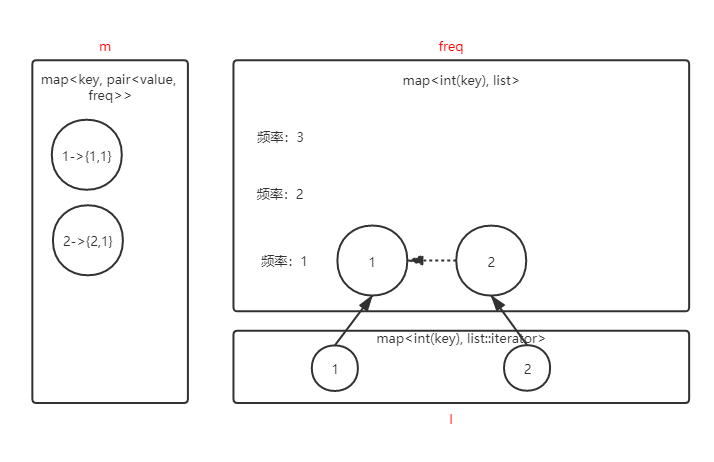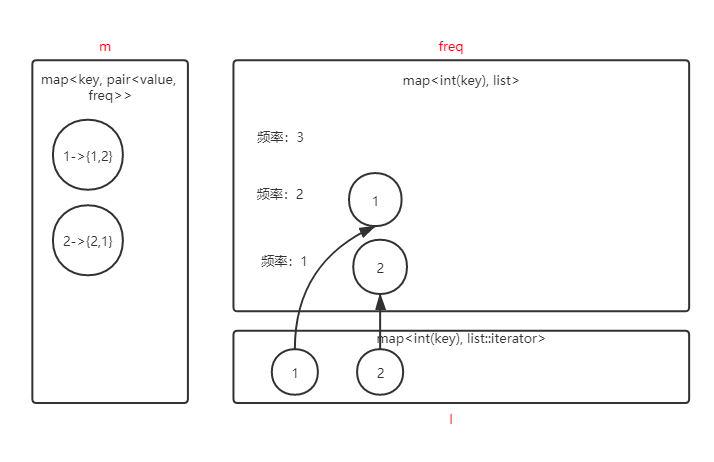LeetCode 460. LFU Cache LFU缓存 (C++/Java)
题目:
Design and implement a data structure for Least Frequently Used (LFU)cache. It should support the following operations: get and put.
get(key) - Get the value (will always be positive) of the key if the key exists in the cache, otherwise return -1.put(key, value) - Set or insert the value if the key is not already present. When the cache reaches its capacity, it should invalidate the least frequently used item before inserting a new item. For the purpose of this problem, when there is a tie (i.e., two or more keys that have the same frequency), the least recently used key would be evicted.
Note that the number of times an item is used is the number of calls to the get and put functions for that item since it was inserted. This number is set to zero when the item is removed.
Follow up:
Could you do both operations in O(1) time complexity?
Example:
LFUCache cache = new LFUCache( 2 /* capacity */ ); cache.put(1, 1);
cache.put(2, 2);
cache.get(1); // returns 1
cache.put(3, 3); // evicts key 2
cache.get(2); // returns -1 (not found)
cache.get(3); // returns 3.
cache.put(4, 4); // evicts key 1.
cache.get(1); // returns -1 (not found)
cache.get(3); // returns 3
cache.get(4); // returns 4
分析:
设计并实现最不经常使用(LFU)缓存的数据结构。相比LRU,LFU增加了频率这一概念,在cache满了的时候,将会把最不经常使用的缓存清除掉,在本题则是以访问频率体现的。
利用hashmap来记录当前数据{key, value}和其出现次数之间的映射,我们可以把出现频率相同的key都放到一个list集合中,再使用一个hashmap建立频率和list之间的映射。为了能够在O(1)的时间内完成操作了,要快速的定位list中key的位置,我们再用一个hashmap来建立key和freq中key的位置之间的映射。最后当然我们还需要两个变量cap和minFreq,分别来保存cache的大小,和当前最小的频率。
我们假设容量为2,先put(1, 1)和put(2, 2),此时容器的存储情况如下:

此时调用get(1,1),我们需要做的操作如下:
1.如果m中不存在key1,那么返回-1
2. 从freq中频率为1(从m中获取到的key对应的频率值)的list中将1删除
3. 将m中1对应的频率值自增1
4. 将1保存到freq中频率为2(当前频率加+1)的list的末尾
5. 在l中保存1在freq中频率为2的list中的位置
6. 如果freq中频率为minFreq的list为空,minFreq自增1
7. 返回m中1对应的value值
经过这些步骤后,我们再来看下此时内部容器情况:

此时再put(3, 3),我们需要做的操作如下:
1. 先调用get(3)返回的结果不是-1,也就是说此时cache中已经存在3这块缓存了,我们可以直接将m中3对应的value更新为当前value,并返回。
2. 如果此时m的大小大于了cap,即超过了cache的容量,则:
a)在m中移除minFreq对应的list的首元素的key。
b)在l中清除3对应的纪录
c)在freq中移除minFreq对应的list的首元素。
3. 在m中建立3的映射,即 3 -> {value 3, frequent1}
4. 在freq中频率为1的list末尾加上3
5. 在l中保存3在freq中频率为1的list中的位置
6. minFreq重置为1
此时内部容器情况:

虚线表示此步骤删去的元素。
程序:
C++
class LFUCache {
public:
LFUCache(int capacity) {
cap = capacity;
}
int get(int key) {
if(m.count(key) == 0)
return -1;
freq[m[key].second].erase(l[key]);
m[key].second++;
freq[m[key].second].push_back(key);
l[key] = --freq[m[key].second].end();
if(freq[minFreq].size() == 0)
minFreq++;
return m[key].first;
}
void put(int key, int value) {
if(cap <= 0)
return;
if(get(key) != -1){
m[key].first = value;
return;
}
if(m.size() >= cap){
m.erase(freq[minFreq].front());
l.erase(freq[minFreq].front());
freq[minFreq].pop_front();
}
m[key] = make_pair(value, 1);
freq[1].push_back(key);
l[key] = --freq[1].end();
minFreq = 1;
}
private:
int cap, minFreq;
unordered_map<int, pair<int, int>> m;
unordered_map<int, list<int>> freq;
unordered_map<int, list<int>::iterator> l;
};
/**
* Your LFUCache object will be instantiated and called as such:
* LFUCache* obj = new LFUCache(capacity);
* int param_1 = obj->get(key);
* obj->put(key,value);
*/
Java
public class LFUCache {
public LFUCache(int capacity) {
cap = capacity;
map = new HashMap<>();
freq = new HashMap<>();
list = new HashMap<>();
minFreq = 1;
}
public int get(int key) {
if(!map.containsKey(key))
return -1;
int count = freq.get(key);
list.get(count).remove(key);
freq.put(key, count + 1);
if(list.get(minFreq).size() == 0)
minFreq++;
if(!list.containsKey(count + 1)){
LinkedHashSet<Integer> set = new LinkedHashSet<Integer>();
set.add(key);
list.put(count+1, set);
}else{
list.get(count+1).add(key);
}
return map.get(key);
}
public void put(int key, int value) {
if(cap <= 0)
return;
if(get(key) != -1){
map.put(key, value);
return;
}
if(map.size() >= cap){
Integer removeKey = list.get(minFreq).iterator().next();
map.remove(removeKey);
list.get(minFreq).remove(removeKey);
freq.remove(removeKey);
}
//System.out.println(map.toString());
map.put(key, value);
freq.put(key, 1);
if(!list.containsKey(1)){
LinkedHashSet<Integer> set = new LinkedHashSet<Integer>();
set.add(key);
list.put(1, set);
}else{
list.get(1).add(key);
}
minFreq = 1;
}
private int cap;
private int minFreq;
private HashMap<Integer, Integer> map;
private HashMap<Integer, Integer> freq;
private HashMap<Integer, LinkedHashSet<Integer>> list;
}
/**
* Your LFUCache object will be instantiated and called as such:
* LFUCache obj = new LFUCache(capacity);
* int param_1 = obj.get(key);
* obj.put(key,value);
*/
LeetCode 460. LFU Cache LFU缓存 (C++/Java)的更多相关文章
- LeetCode:146_LRU cache | LRU缓存设计 | Hard
题目:LRU cache Design and implement a data structure for Least Recently Used (LRU) cache. It should su ...
- [LeetCode] 460. LFU Cache 最近最不常用页面置换缓存器
Design and implement a data structure for Least Frequently Used (LFU) cache. It should support the f ...
- [LeetCode] LFU Cache 最近最不常用页面置换缓存器
Design and implement a data structure for Least Frequently Used (LFU) cache. It should support the f ...
- leetcode 146. LRU Cache 、460. LFU Cache
LRU算法是首先淘汰最长时间未被使用的页面,而LFU是先淘汰一定时间内被访问次数最少的页面,如果存在使用频度相同的多个项目,则移除最近最少使用(Least Recently Used)的项目. LFU ...
- Leetcode: LFU Cache && Summary of various Sets: HashSet, TreeSet, LinkedHashSet
Design and implement a data structure for Least Frequently Used (LFU) cache. It should support the f ...
- LeetCode LFU Cache
原题链接在这里:https://leetcode.com/problems/lfu-cache/?tab=Description 题目: Design and implement a data str ...
- LeetCode之LRU Cache 最近最少使用算法 缓存设计
设计并实现最近最久未使用(Least Recently Used)缓存. 题目描述: Design and implement a data structure for Least Recently ...
- [LeetCode] 146. LRU Cache 最近最少使用页面置换缓存器
Design and implement a data structure for Least Recently Used (LRU) cache. It should support the fol ...
- LFU Cache
2018-11-06 20:06:04 LFU(Least Frequently Used)算法根据数据的历史访问频率来淘汰数据,其核心思想是“如果数据过去被访问多次,那么将来被访问的频率也更高”. ...
- LRU缓存实现(Java)
LRU Cache的LinkedHashMap实现 LRU Cache的链表+HashMap实现 LinkedHashMap的FIFO实现 调用示例 LRU是Least Recently Used 的 ...
随机推荐
- vue3.0体验版生命周期
使用方法:cnpm install --save @vue/composition-api在组件内引入 把上图的 onMounted 换成(2.6->3.0) beforeCreate-> ...
- Docker部署Node应用简单实践
简介: 本文将从零至一,介绍如何在云服务器上通过 Docker 容器运行一个简单的Node应用. 前言 本文将从零至一,介绍如何在云服务器上通过 Docker 容器运行一个简单的Node应用.本文假设 ...
- [PHP] composer, PHP Fatal error: Allowed memory size of xx bytes exhausted
终端执行 composer 命令时经常会遇到内存不够的情况. 视情况升级一下 composer,使用 composer self-update. 默认 php 的内存限制是 128M,临时取消 php ...
- [FE] JS 判断当前是否在微信浏览器中的最新代码
注意以下使用了 const 定义未改变的变量,没有使用 var. function isWeChatBrowser () { const ua = window.navigator.userAgent ...
- 大模型_2.2:Prompt示例
1.行业洞察分析 行业洞察分析的方法论:使用麦肯锡工作法可以快速了解一个行业. Step1:通过搜索分析几十个与该行业相关的关键词,覆盖该行业的上下游,以获取全面的信息. Step2:阅读一些行业最新 ...
- linux-centos7.6-gpt-uefi安装
目录 linux-centos7.6-gpt-uefi安装 一.需要 二.环境 三.vm新建虚拟机系统环境 四.开始安装 linux-centos7.6-gpt-uefi安装 一.需要 安装的系统适用 ...
- 02.go-admin IDE配置配置命令启动方式讲解笔记
目录 go-admin版本 视频地址 一.代码地址 二.在线文档 三.首次配置需要初始化数据库资源信息(已初始化过数据库的,跳过此步) 配置数据库迁移 五.配置启动项目,用goland IDE进行启动 ...
- Docker 必知必会2----跟我一步步来执行基本操作
通过前文(https://www.cnblogs.com/jilodream/p/18177695)的了解,我们已经大致明白了什么是docker,为什么要用docker,以及docker的基本设计思路 ...
- C++ 初始化列表(Initialization List)
请注意以下继承体系中各class的constructors写法: 1 class CPoint 2 { 3 public: 4 CPoint(float x=0.0) 5 :_x(x){} 6 7 f ...
- AIRIOT物联网低代码平台如何配置OPC UA驱动?
AIRIOT物联网低代码平台支持驱动类型丰富,驱动包括但不限于通用驱动信息,无线驱动信息,行业驱动信息及各个厂商驱动.驱动稳定性强,经受住各个大型项目考验,持续稳定运行. AIRIOT物联网低代码平台 ...
